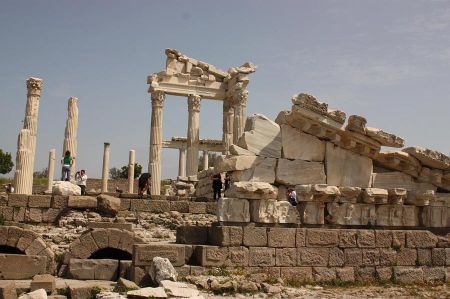Pergamon and the replica of the Pergamon Altar
- Written by Portal Editor
Pergamon was famous in ancient times primarily for its extraordinarily extensive library. Today in Pergamon (today's name: Bergama) you can still visit the Acropolis (the castle hill), the former city and the Asklepieion.
These sights are part of ancient Pergamon. Since there is a lot to see in Pergamon, you should take a whole day to visit.
Pergamon and the replica of the Pergamon Altar - ancient splendor rediscovered
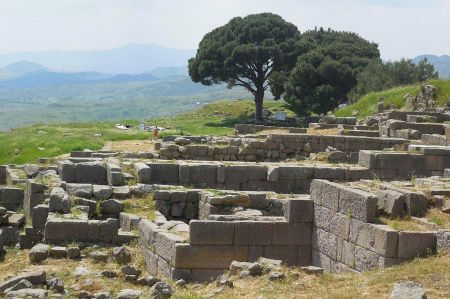 The Acropolis is in the north of Bergama. Up there you can see a replica of the Pergamon Altar. The original is in the Pergamon Museum on the Museum Island in Berlin. Next to the Pergamon Altar are the theater, several altars, temple complexes and the Upper Agora (the upper market square). The Ancient Road leads down to the former city. Here you will find thermal baths, temple complexes and the Lower Agora.
The Acropolis is in the north of Bergama. Up there you can see a replica of the Pergamon Altar. The original is in the Pergamon Museum on the Museum Island in Berlin. Next to the Pergamon Altar are the theater, several altars, temple complexes and the Upper Agora (the upper market square). The Ancient Road leads down to the former city. Here you will find thermal baths, temple complexes and the Lower Agora.
On the opposite side of Bergama, about a kilometer from the Lower Town, is the Asklepieion, another collection of several ancient buildings that were a very well-known health resort in ancient times. The Asklepieion was famous for its excellent sanatorium and the physician Galen. There is a spa, a small theater, the library and temple complexes here.
Excavations by engineer Carl Humann on the castle hill of Pergamon
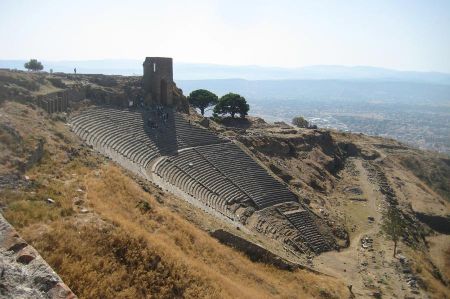 The Pergamon Altar is a monumental altar that was built under King Eumenes II in the first half of the 2nd century BC on the castle hill of the Asia Minor city of Pergamon. Its partial reconstruction with the original friezes is in the Pergamon Museum in Berlin.
The Pergamon Altar is a monumental altar that was built under King Eumenes II in the first half of the 2nd century BC on the castle hill of the Asia Minor city of Pergamon. Its partial reconstruction with the original friezes is in the Pergamon Museum in Berlin.
The altar was 35.64 meters wide and 33.40 meters deep. The open staircase leading to the altar from the west was almost 20 meters wide. It is one of the most important surviving works of art from Hellenism, if not from ancient Greece as a whole: the base was decorated with a high relief depicting the battle of the giants against the Greek gods. A second frieze on the courtyard walls of the Pergamon Altar tells the legend of Telephos in a cycle of successive relief images. Telephos, a son of the hero Heracles and the Tegean king's daughter Auge, was considered the mythical founder of Pergamon.
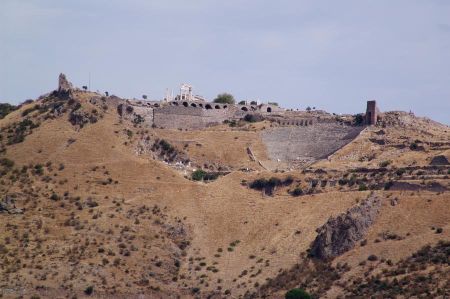 In 1878, the German engineer Carl Humann began official excavations on the castle hill of Pergamon, which were provisionally completed in 1886. The main aim of the excavations was to recover the altar friezes and uncover the foundation of the altar. Later, other building complexes of the Pergamene Acropolis were uncovered. In negotiations with the Turkish government involved, it was agreed that all fragments of the altar friezes found at that time would be awarded to the Berlin museums.
In 1878, the German engineer Carl Humann began official excavations on the castle hill of Pergamon, which were provisionally completed in 1886. The main aim of the excavations was to recover the altar friezes and uncover the foundation of the altar. Later, other building complexes of the Pergamene Acropolis were uncovered. In negotiations with the Turkish government involved, it was agreed that all fragments of the altar friezes found at that time would be awarded to the Berlin museums.
Pergamon, one of the most impressive ancient cities in Turkey, fascinates with its rich history, unique architecture and world-famous monuments. The Pergamon Altar in particular, one of the greatest masterpieces of Hellenistic art, continues to attract historians, archaeologists and tourists from all over the world.
While the ruins of Pergamon are located in the present-day city of Bergama (western Turkey), the Pergamon Altar is an elaborate replica in the Pergamon Museum in Berlin, where it has been one of the most important exhibits for over a century.
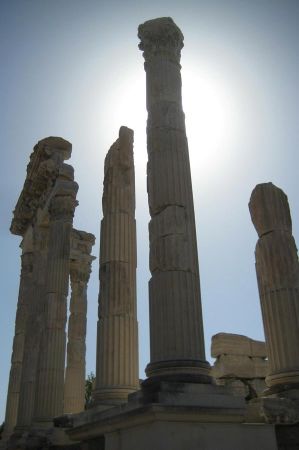 In Berlin, Italian restorers reassembled the panels of the friezes from thousands of fragments. In order to be able to exhibit the friezes together, a museum was specially built on the Museum Island.
In Berlin, Italian restorers reassembled the panels of the friezes from thousands of fragments. In order to be able to exhibit the friezes together, a museum was specially built on the Museum Island.
The first building from 1901 was demolished in 1909 to make way for a larger new building, which was completed in 1930.
The Berliners named this new museum the Pergamon Museum after the friezes exhibited there and a reconstruction of the west front of the Pergamon Altar.
The room with the Pergamon Altar has been closed since 2014 due to extensive renovation work and is expected to remain closed until at least 2027.
Pergamon and the replica of the Pergamon Altar - Ancient splendour rediscovered
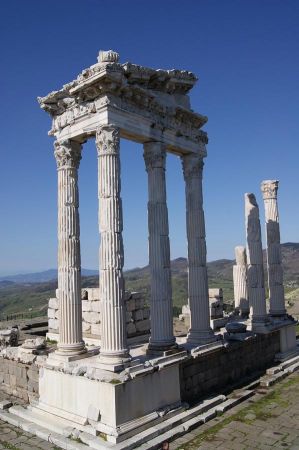 The Pergamon Altar is today the most famous exhibit in the collection of antiquities on Museum Island.
The Pergamon Altar is today the most famous exhibit in the collection of antiquities on Museum Island.
Pergamon, one of the most impressive ancient cities in Turkey, fascinates with its rich history, unique architecture and world-famous monuments.
The Pergamon Altar in particular, one of the greatest masterpieces of Hellenistic art, continues to attract historians, archaeologists and tourists from all over the world.
While the ruins of Pergamon are located in the modern-day city of Bergama (Western Turkey), the Pergamon Altar is an elaborate replica in the Pergamon Museum in Berlin, where it has been one of the most important exhibits for over a century.
The history of Pergamon - Ancient metropolis with cultural heritage
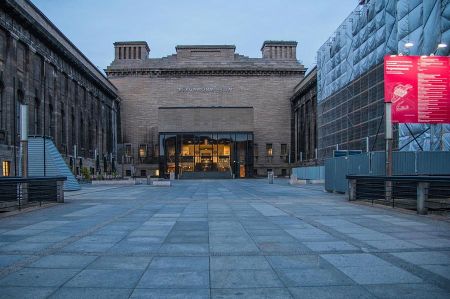 The city of Pergamon was founded in the 3rd century BC as a powerful residence of the Attalid dynasty and quickly developed into a centre for art, science and architecture. It was known for:
The city of Pergamon was founded in the 3rd century BC as a powerful residence of the Attalid dynasty and quickly developed into a centre for art, science and architecture. It was known for:
The famous library of Pergamon - One of the largest in antiquity with over 200,000 scrolls.
The steepest ancient theatre in the world - With breathtaking views of the valley.
Temples, sanctuaries and magnificent buildings that shaped the cityscape.
The most famous landmark, however, was the monumental Pergamon Altar, which was dedicated to the father of the gods Zeus and the goddess Athena.
The Pergamon Altar - A masterpiece of Hellenistic art
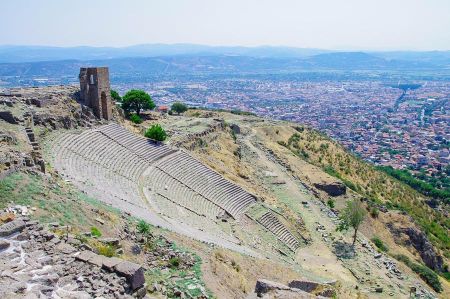 The Pergamon Altar was built around 180-160 BC and impressed with its massive staircases, columns and artistic reliefs. It depicted the dramatic scene of the battle of the giants (Gigantomachy) - an epic battle between the Olympian gods and the giants.
The Pergamon Altar was built around 180-160 BC and impressed with its massive staircases, columns and artistic reliefs. It depicted the dramatic scene of the battle of the giants (Gigantomachy) - an epic battle between the Olympian gods and the giants.
Its artistic friezes, which were over 120 meters long, showed mythological figures in lively movement and dynamic composition. The altar was not only a religious centre, but also a symbol of the power and culture of Pergamon.
Unfortunately, the original of the altar was brought to Berlin by German archaeologists in the 19th century and exhibited there in the Pergamon Museum.
The replica of the Pergamon Altar - A piece of antiquity in Berlin
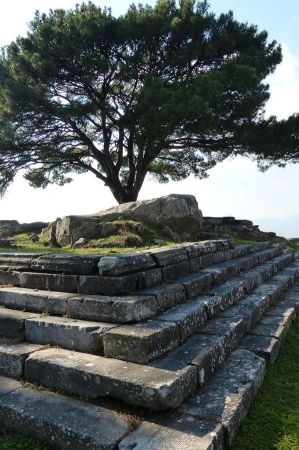 Today, the Pergamon Altar is on display as a replica and reconstruction in the Pergamon Museum on Berlin's Museum Island. This museum is one of the most important in the world and offers a unique insight into ancient architecture.
Today, the Pergamon Altar is on display as a replica and reconstruction in the Pergamon Museum on Berlin's Museum Island. This museum is one of the most important in the world and offers a unique insight into ancient architecture.
Original fragments and reliefs - The impressive friezes with their detailed sculptures.
3D reconstructions - Virtual representations of the former splendour of the altar.
Historical documentation - Information about the excavations and the history of Pergamon.
The altar is one of the most visited exhibits in Germany, and its artistic value makes it an irreplaceable cultural heritage of antiquity.
Sights in Pergamon - Discover ancient treasures
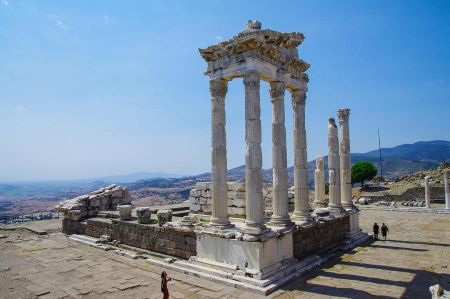 Although the altar is in Berlin, the ancient city of Pergamon offers numerous impressive sights:
Although the altar is in Berlin, the ancient city of Pergamon offers numerous impressive sights:
The Acropolis of Pergamon - The spectacularly located city complex with palaces and temples.
Asklepieion sanctuary - An ancient centre for medicine and healing.
Red Hall (Serapeion) - An impressive Roman temple, later an early Christian church.
Cable car to the Acropolis - A breathtaking ride with a view of the ruined city.
Pergamon is a UNESCO World Heritage Site and a must for anyone who wants to experience the fascinating history of antiquity up close.
Conclusion - A heritage that makes history
The Pergamon Altar and the ancient city of Pergamon are impressive testimonies to Hellenistic culture. While the original can be admired in Berlin, Bergama in Turkey invites you to explore the remains of this once mighty metropolis.
Whether in Pergamon itself or in the Pergamon Museum in Berlin – this cultural heritage remains a fascinating window into the past!
Please read as well:
